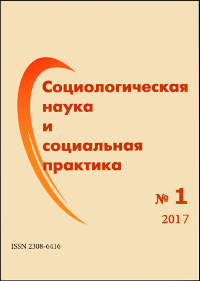Классовые схемы постиндустриального общества в западной социологии
Аннотация
Литература
Бек У. Общество риска. На пути к другому модерну / Пер. с нем. В. Седельника, Н. Фёдоровой; посл. А. Филиппова. М.: Прогресс-Традиция, 2000. 480 с.
Гидденс Э. Социология / Пер. с англ.; науч. ред. В. А. Ядов; общ. ред. Л. С. Гурьевой, Л. Н. Посилевича. М.: Едиториал УРСС, 1999. 703 с.
Кастель Р. Метаморфозы социального вопроса. Хроника наёмного труда / Пер. с фр.; под общ. ред., ред. пер. Н. А. Шматко. СПб.: Алетейя, 2009. 574 с.
Тощенко Ж. Т. Прекариат — новый социальный класс // Социологические исследования. 2015. № 6. С. 3—13.
Шкаратан О. И. Социология неравенства. Теория и реальность. М.: Изд. дом Высшей школы экономики, 2012. 526 с.
Bison I. Education, Social origins and career (im)mobility in contemporary Italy: A holistic and categorical approach // European Societies. 2011. Vol. 13. № 3. P. 481—503.
Frase P. The Precariat: A Class or a Condition? // New Labor Forum. 2013. May 29. URL: http://newlaborfbmm.cuny.edu/2013/05/29/the-precariat-a-class-or-a-condition/ (дата обращения: 29.01.2017).
Giddens A. Central problems in social theory. Action, structure and contradiction in social anal¬ysis. London: The Macmillan Press, 1979.
Goldthorpe J. H., Llewellyn C., P. Clive. Social Mobility and Class Structure in Modern Britain. 2nd ed. Oxford: Clarendon Press. 1987.
Savage M., Devine F., Cunningham N., Taylor M., Li Y., Hjellbrekke J., Le Roux B., Friedman S., Miles A. A New Model of Social Class? Findings from BBC’S Great British Class Survey Experiment // Sociology. 2013. № 47 (2). Р. 219—250.
Scambler G. Taking social class seriously [Электронный ресурс] // GrahamScambler. Feb. 11. 2015. URL: //http: www.grahamscambler.com/taking-social-class-seriously/ (дата обращения: 04.07.2015).
Seymour R. We Are All Precarious — On The Concept Of The ‘Precariat’ And Its Misuses. New Left Project. 10.02.2012. [Электронный ресурс] // New Left Project URL: //http: www.newleft- proiect.org/index.php/site/artlcle_comments/we_are_all_precarious_on_the_concept_of_the_pre- cariat_and_its_misuses (дата обращения: 05.05.2015).
Standing G. O precariado e a luta de classes [The precariat and class struggle] // Revista Critica de Ciencias Sociais (Portugal). № 103. May 2014. Р. 9—24.
Standing G. The Precariat — The New dangerous class. London: Bloomsbury Academic, 2011. WrightE. O. Classes. London: Verso, 1985.








